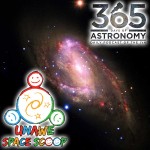Podcaster: Richard Drumm
 Title: Space Scoop: May the Force be with You
Title: Space Scoop: May the Force be with You
Organization: 365 Days Of Astronomy
Link : astrosphere.org ; http://unawe.org/kids/unawe1265/
Description: Space scoop, news for children.
Bio: Richard Drumm is President of the Charlottesville Astronomical Society and President of 3D – Drumm Digital Design, a video production company with clients such as Kodak, Xerox and GlaxoSmithKline Pharmaceuticals. He was an observer with the UVa Parallax Program at McCormick Observatory in 1981 & 1982. He has found that his greatest passion in life is public outreach astronomy and he pursues it at every opportunity.
Today’s sponsor: This episode of “365 Days of Astronomy” is sponsored by — no one. We still need sponsors for many days in 2015, so please consider sponsoring a day or two. Just click on the “Donate” button on the lower left side of this webpage, or contact us at signup@365daysofastronomy.org.
Transcript:
This is 365 Days of Astronomy. Today we bring you a new episode in our Space Scoop series. This show is produced in collaboration with Universe Awareness, a program that strives to inspire every child with our wonderful cosmos.
Today’s story is:
May the Force be with You
The beautiful galaxy in the image in today’s podcast album artwork is Messier 66, or NGC 3627, a part of a system of three galaxies bound together by gravity, called the “Leo Triplet” or the “Leo Trio”. Its spiral shape has been pulled out of kilter by its neighbors.
Can you see that it’s longer on the right side? This is because the three galaxies are constantly tugging at each other.
Gravity is something we mention a lot when talking about astronomy, because it plays such an important role in shaping our Universe. Gravity is a force that attracts all objects that have mass, toward each other. It’s why we don’t fall off the Earth even though it’s round.
The more massive an object is, the stronger its gravitational pull. This is why gravity on the Earth is stronger than on the Moon, and why people feel lighter on the moon – about six times lighter, in fact!
We experience gravity here on Earth because we have mass. Objects with mass experience gravity as weight. So when we say something weighs a large amount, we really mean that it just has a lot of mass.
Gravity doesn’t just keep humans on the Earth, it also keeps the planets in our Solar System tied to the Sun. It holds together the gas, dust and billions of stars of the Milky Way.
Even galaxies don’t wander through space alone though, there are groups of galaxies that are bound together and the Leo Trio is one such group.
The Milky Way belongs to a trio too! The Local Group is the prosaic name for our galaxy cluster. It includes the Milky Way, M31, the Andromeda Galaxy, and M33, the Triangulum Galaxy.
There are a number of dwarf galaxies trapped in our gravity field too, but it’s mostly the 3 of us. You listeners in the Southern Hemisphere can see 2 of the other galaxies quite easily. They are the Large and Small Magellanic Clouds.
The Leo Trio is composed of M65, M66 and NGC 3628.. You can see a picture of the entire group by Googling “Leo Trio” or “Leo Triplet.” It may be that the Leo Trio is also a part of the M96 Group, composed of 8 galaxies.
The Leo Trio and the M96 Group are located physically near each other in the Universe and it’s a little hard to tell if they are gravitationally bound to each other.
Hey, Here’s A Cool Fact:
So what do we mean when we say that the astronauts in the ISS are weightless? Well, it’s just a way of saying that they don’t experience gravity like we do. We are drawn by gravity toward Earth and our feet make contact with the dirt outside or the floor of a building, giving us the experience of having weight.
On The ISS, the astronauts are basically in free fall as they travel around the Earth. They are falling at the same rate as the ISS is itself, so the astronauts’ feet don’t get plastered to the floor of the ISS modules.
Earth’s gravity is up there all right, it’s 80% as strong as it is here on the surface. It’s just that the astronauts can’t feel its effects.
And they wish they could, too! As much fun as it looks like to be floating around, the feeling of weightlessness is the feeling of falling and that makes it hard to sleep up there.
Thank you for listening to 365 Days of Astronomy!
End of podcast:
365 Days of Astronomy
=====================
The 365 Days of Astronomy Podcast is produced by Astrosphere New Media. Audio post-production by Richard Drumm. Bandwidth donated by libsyn.com and wizzard media. You may reproduce and distribute this audio for non-commercial purposes. Please consider supporting the podcast with a few dollars (or Euros!). Visit us on the web at 365DaysOfAstronomy.org or email us at info@365DaysOfAstronomy.org. This year we will celebrate more discoveries and stories from the universe. Join us and share your story. Until tomorrow! Goodbye!

